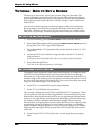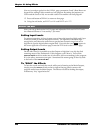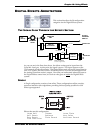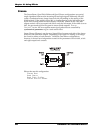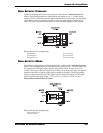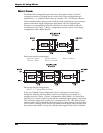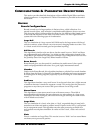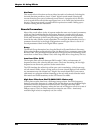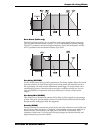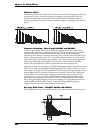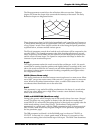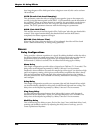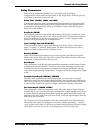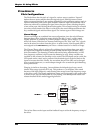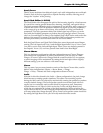
Chapter 10: Using Effects
216 ANDROMEDA A6 REFERENCE MANUAL
Nonlinear
This reverb effect’s direction can be set either forwards or backwards. Selecting the
forward direction provides a classic “Gated” digital reverb sound. Selecting the
reverse direction gives you a backwards reverb sound. A popular trick in the 80’s
was to record the reverb with the tape flipped over, so it would play backwards in
the mix. The reverse reverb is a useful effect for percussive sounds -adding space
without washing out the instrument.
Reverb Parameters
Most of the reverb effects in the A6 operate under the same set of control parameters,
which are listed and described in this section. However, reverbs which use more
processing power (i.e. the Single configuration reverbs) provide more parameters
which take advantage of their extra processing power; parameters which are not
found in the other, smaller reverb algorithms. For example, Reverberation Swirl is a
parameter found only in the Single configuration reverb types. Here is a list of all
reverb parameters found in the Digital Effects system:
Decay
The Reverb Decay determines how long the Reverb will sound before it dies away.
When using the Reverse Reverb effect type, the Reverb Decay parameter controls the
Reverse Time. This parameter dictates the size of the space you are emulating: small
rooms have a short decay (500ms-2 Sec) while large halls have a long decay (2-6 Sec).
Low Pass Filter (LPF)
The lowpass filter can be set between 029 Hz and 41.3 kHz, and attenuates all
frequencies above this value by 6dB per octave. The lower the setting, the less high
frequencies are allowed to pass thru to the reverb effect.
The LPF simulates the reflectivity of the space you’re emulating. A tiled room may
roll off around 12kHz, where a living room or a warm church might roll off at 6kHz.
An instrument may also dictate how “bright” the reverb should be. If you want to
add sustain to a program without cluttering up the mix with reverb from the initial
filter attack and initial transients, set the LPF around 2 or 4kHz.
High Pass Filter/Low Shelf (LSHELF/HPF--Plates only)
Classic plate reverbs often have a midrangy twang to them. Since this frequency
bump is part of the character of a plate reverb, the A6 allows you to roll off the highs
(see above) and low frequencies on Plate reverbs. The High Pass Filter (HPF)
parameter controls the frequency where the low end will begin to roll off (at a rate of
6dB per octave). The Low Shelf controls how deep the cut will be - from barely
noticable (high value) to completely cut (low value).



